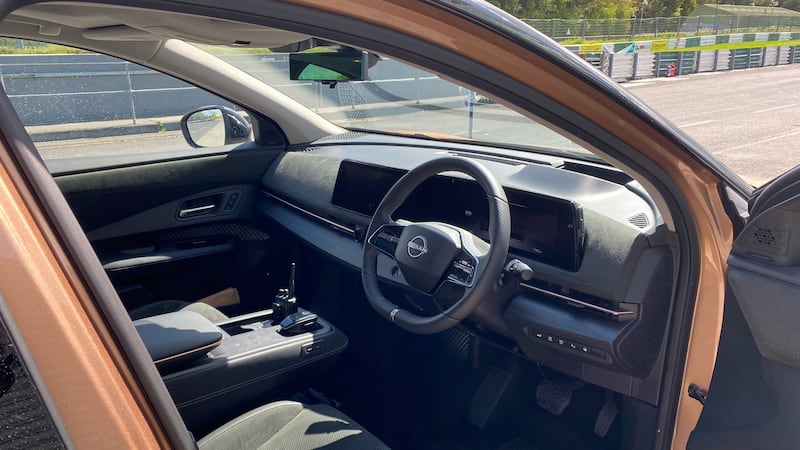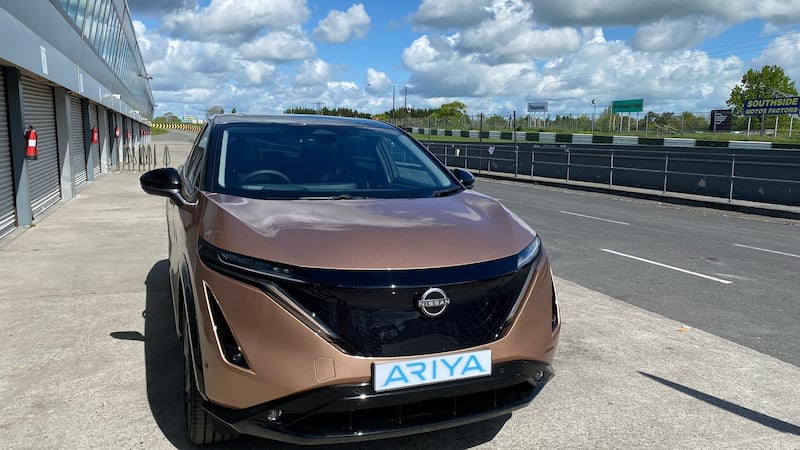It feels odd, very odd, to be driving an electric car on a race track. Race tracks are all about hard acceleration, enthusiastic cornering, and leaving your braking as late as you dare. Electric cars are, in general, about none of those things. More typically, they’re about driving as gently as possible, carefully husbanding precious battery range and treating the accelerator pedal as if there’s a live wire running through it.
So why are we driving the new Nissan Ariya on the twisting tarmac of Mondello Park race track, near Naas? Well, it says less about the Ariya's performance than it does about journalistic driving standards - this car is a precious pre-production model, one that has to go on a national tour of Nissan's dealerships when we're done with it. So staying within the confines of Mondello is more about making sure the car comes back unscathed, rather than any attempts at an EV lap record.
‘Have a go’
Having said that, we’re not kid-gloving it - I am instructed at one point to ‘switch on sport mode and have a go…’ and duly do so, but first let’s have a look at what exactly an Ariya is. It is, significantly, Nissan’s second all-electric car, following on from the Leaf. That’s a good, long follow-on if you think that the second-generation Leaf has been with us for the guts of five years now. Nissan would have capitalised much more swiftly on the Leaf’s success, but a combination of Covid and supply chain problems conspired to delay the Ariya’s debut.
At least Nissan hasn’t used the time to tinker needlessly with the styling. The Ariya marks a distinct change from the rather-too-conventional Leaf, and has kept most of its concept car styling. Even in the unprepossessing surrounds of the Mondello pitlane, it looks great, especially in the bright copper colour option.
Inside, it's even better. This is, by some length, the best interior that Nissan has yet crafted (with only the hand-made GTR supercar even coming close). There are lashings of soft-touch Alcantara suede, a pair of neat, clear digital screens, and some rather lovely-looking (but slightly fiddly to use) touch-sensitive controls for the heating and air conditioning. Quality levels are high, and the whole thing looks and feels like a big step on from the current Qashqai.

There are some genuine oddities too, which is actually a good thing in an age of homogenous interior design. The centre console slides back and forth electrically (not sure why, really, but it’s a neat effect), and there’s a bonus glovebox under the central screen that also opens and closes electrically, rather like some sort of Thunderbirds option pack. The normal glovebox next door is just that - normal. You pull a latch and it opens. Ah well…
Renault links
Under the skin, it uses the CMF-EV platform which is shared with Nissan’s long-standing partner, Renault (Renault uses it for the new Megane E-Tech). That means you get a liquid-cooled battery pack, which should be more efficient and better at dealing with extremes of temperature than the Leaf’s older, air-cooled design. Actually, you get two battery packs - a 63kWh model, which quotes a 402km range; and an 87kWh version that should go for around 530km. We say ‘around’ as the Ariya has not yet been fully homologated, and the final, official, WLTP figures may fall at either end of those two ballparks.
Our test car is the 63kWh version, with a 217hp electric motor, driving the front wheels. Nissan Ireland reckons that this will be the best-selling version, probably in the higher of the two trim levels. The 87kWh version comes with a 241hp motor, or you could wait for the 390hp e-Force four-wheel drive version that arrives next year, but don’t expect many Irish customers to hold out for that one.
As you’d expect, the Ariya is a refined car, but its refinement is excellent even by the lofty standards of electric cars. All is almost entirely silent until you pass about 90km/h, at which point you start to notice a faint flurry of wind noise around the door mirrors, but it’s not enough to intrude. If I’d had the stereo on, I’d probably not have noticed it. It’s a bit hard to judge ride quality when driving on a smooth race track, but a few excursions across Mondello’s saw-tooth kerbs seemed to suggest that the Ariya is well-damped, and pretty supple when dealing with bumps.
Steering
The way it steers is quite surprising - the steering is much sharper and more aggressively-geared than I expected, and you can tuck the Ariya’s nose deep into a briskly taken corner. It rolls, of course, but the roll arrives early, settles quickly, and once it has done so the Ariya feels impressively neutral all the way through to when you straighten up the steering again. Door-handling around a race track will, doubtless, not be very high on Ariya buyers’ criteria, but it’s clear that the chassis tuning has been done with deftness and wit, and it’s a massive improvement over the rather more pedestrian Leaf. Activate the ‘one-pedal’ regenerative braking system, and you soon learn you can use a flex of your right foot to induce a weight-transfer, which balances the Ariya nicely for an upcoming corner.
The battery range should hold up pretty well, too. Even being repeatedly thrashed around Mondello, the Ariya was indicating a range of more than 220km on a not-quite-full battery, which is good going for a car being driven quite a long way outside its normal comfort zone.

It’ll be a practical family car, too. There’s a decent 468-litre boot in front-wheel drive guise (which uses the Qashqai’s neat flip-up floor dividers) and there’s copious legroom in the back seats, not to mention just about enough width to get three passengers (or car seats) in comfortably. Only rear headroom is an issue - that swooping roof comes down enough to impinge a little for anyone around 6” tall.
Other niggles? Well, there’s no ‘frunk’ boot at the front, so your charging cables will have to go in with your luggage, and the main digital instrument display - as it does in the Qashqai - looks a little plain and simple for a car this sophisticated. On the upside, you get a plethora of electronic driver aids as part of Nissan’s ‘ProPilot’ and ‘Safety Shield’ systems, including lane keeping, active cruise, and both a 360-degree camera system and a heads-up display.
Pricing
Price-wise, the Ariya is treading something of a fine balance. The basic 63kWh model starts from €48,995 in Advance trim. That makes it more expensive than both the Volkswagen ID.4 77kWh and the Toyota bz4X 75kWh versions, and about on a par with the 73kWh version of the Hyundai Ioniq 5, with a shorter range than any of them. The most expensive Ariya, for now, will be the €66,995 87kWh version in top-spec Evolve trim, at which point it's actually looking like slightly better value against an ID.4 Max.
Pricing is all-but irrelevant for now, though. Nissan could be charging customers in Ducats or Florins, and there would still be a queue around the block. As with most newly launched cars this year, supply will be very tight initially, although Nissan Ireland has ambitions to sell around 1,500 in a full, relatively-normal year. That would put it on a path to potentially match this year’s best-selling EV so far, the Hyundai Ioniq 5.
The Ariya, on this encounter, definitely feels like a step forward. It feels almost on a different planet to the much simpler Leaf (a car which remains exceptional value for money in short-ranged 40kWh form), and in high-spec form could almost be said to be a premium product, certainly in its cabin design, fit, and finish. It will take some years yet for the fast-expanding electric car market to shake out, and a true hirearchy to establish itself, but the Ariya is definitely hitting some high notes.











